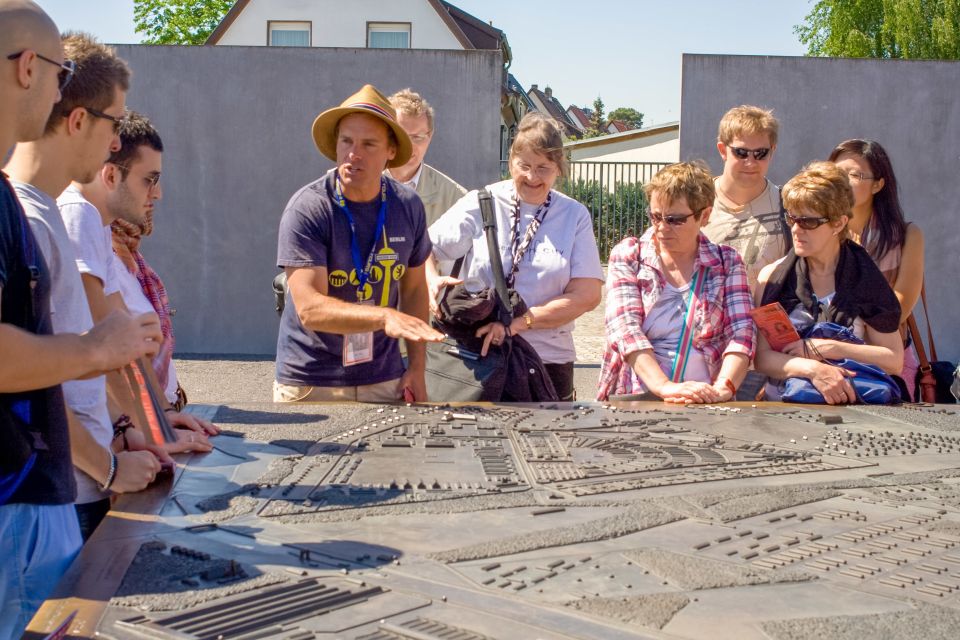The Sachsenhausen Concentration Camp Memorial in Berlin offers a profound and unsettling glimpse into the horrors of the Nazi regime. A 4-hour guided bus tour leads visitors through the former camp, where they’ll confront the grim realities of the systematic brutality that claimed over 35,000 lives. Beyond the historical significance, the tour also explores the camp’s repurposing by the Soviets after World War II, shedding light on the long-lasting impact of this site’s traumatic past. For those seeking to deepen their understanding of this chapter in history, the Sachsenhausen tour provides a harrowing yet essential experience.
Key Points
- This 4-hour guided bus tour provides an immersive exploration of the Sachsenhausen Concentration Camp Memorial, exposing visitors to the camp’s harrowing history.
- Visitors will be led through key locations within the former Nazi camp, including the infirmary barracks, commandant’s house, gas chamber, and punishment cells.
- The tour aims to deepen understanding of the systematic brutality of the Nazi regime and the significant impact of the camp’s history.
- The tour includes transportation, entry to the memorial, a donation to the site, and a map to enhance the educational experience.
- Visitors should expect a physically demanding tour and are advised to dress appropriately and bring light refreshments.
Tour Overview
The 4-hour guided bus tour of the Sachsenhausen Concentration Camp Memorial allows visitors to explore the former Nazi camp and learn about its harrowing history.
During the tour, guests will visit key locations within the camp, such as the commandant’s house, gas chamber, and punishment cells. They’ll also drive through Oranienburg and see where inmates were forced to work.
The tour provides an immersive experience, enabling visitors to step inside the camp where over 35,000 people perished. Plus, the tour covers how the Soviets re-purposed Sachsenhausen as a special camp after World War II.
With a knowledgeable guide leading the way, this small group tour offers a poignant and educational look into this dark chapter of history.
Highlights of the Tour
Visitors on the tour can explore the interior of the former Sachsenhausen Concentration Camp, where over 35,000 people died.
They’ll drive through Oranienburg and see the locations where inmates were forced to work.
The tour also covers the infirmary barracks, where experimentation on prisoners took place.
Plus, the guide explains how Sachsenhausen was later re-purposed by the Soviets as a special camp after World War II.
Key highlights include witnessing the commandant’s house, gas chamber, and punishment cells, all of which provide a sobering glimpse into the horrific realities of life within the camp.
Through this immersive experience, visitors gain a deeper understanding of the history and significance of this notorious concentration camp.
Inclusions in the Tour

The tour includes a guide, transportation in an air-conditioned vehicle, entry to the Sachsenhausen Memorial, a €3 donation per person to the memorial, and a map of the former concentration camp. This ensures visitors have a comprehensive and informative experience throughout the 4-hour guided tour.
With the guide’s expertise, travelers can explore key locations within the camp, such as the commandant’s house, gas chamber, and punishment cells.
The air-conditioned vehicle provides comfortable transportation, while the Sachsenhausen Memorial entry and donation support the preservation and education efforts of the site.
Lastly, the map serves as a helpful reference for navigating the expansive former concentration camp during the tour.
Meeting Point and Identification
Guides will meet participants outside Friedrichstraße train station, on the square between the Tränenpalast (Palace of Tears) and the station. They’ll be wearing blue lanyards and yellow name tags, and holding yellow umbrellas to ensure easy identification. This convenient meeting point makes it simple for tour-goers to find the group.
Once gathered, the guides will lead the group on a comprehensive 4-hour bus tour of the Sachsenhausen Concentration Camp Memorial. Along the way, they’ll share insightful historical details and point out key locations within the former Nazi camp, providing participants with a meaningful and informative experience.
Important Considerations
As it’s a physically demanding tour, participants should wear weather-appropriate clothing and comfortable walking shoes. Bringing a light snack and drink is also recommended, as the 4-hour duration can be taxing.
Plus, since the tours tend to sell out, guests are advised to book their spots in advance to avoid disappointment.
The Sachsenhausen Concentration Camp Memorial tour provides a poignant and immersive experience, allowing visitors to explore the former Nazi camp and learn about its harrowing history. By keeping these important considerations in mind, travelers can ensure they’re prepared for an informative and impactful visit to this solemn historical site.
Sachsenhausen’s Nazi History
Sachsenhausen Concentration Camp, established in 1936, was one of the first and largest Nazi concentration camps, playing a crucial role in the Third Reich’s system of terror and oppression.
Located just outside Berlin, the camp initially housed political prisoners, but later expanded to incarcerate Jews, Roma, Sinti, and other ‘undesirable’ groups.
Inmates were subjected to brutal treatment, including forced labor, medical experimentation, and summary executions.
The camp’s layout and facilities were designed to maximize surveillance and control over the prisoners, exemplifying the Nazis’ dehumanizing ideology.
Tragically, over 35,000 people perished at Sachsenhausen before its liberation by Soviet forces in 1945.
The camp’s dark history serves as a somber reminder of the atrocities committed during the Holocaust.
Sachsenhausen’s Soviet Repurposing
After the camp’s liberation by Soviet forces in 1945, Sachsenhausen was repurposed as a special camp by the Soviets, holding political prisoners and German POWs until its closure in 1950.
The Soviets used the existing infrastructure to house and interrogate their own detainees, including those accused of opposing the communist regime. Conditions in the post-war Soviet camp were harsh, with many inmates dying from malnutrition, disease, and mistreatment.
The repurposing of Sachsenhausen highlights how the site was exploited by successive totalitarian regimes, underscoring the enduring impact of the camp’s traumatic history.
Today, the Sachsenhausen Memorial serves as a solemn reminder of the atrocities committed and the suffering endured by those imprisoned within its walls.
Importance of the Memorial
The Sachsenhausen Memorial serves as a profound reminder of the camp’s harrowing history, bearing testament to the immense suffering and atrocities perpetrated against its imprisoned population.
Visitors to the site are confronted with the grim realities of the Nazi regime’s systematic brutality, an experience that underscores the critical importance of preserving and honoring the memory of those who perished within Sachsenhausen’s walls.
The memorial educates and inspires visitors to reflect on the lessons of the past, promoting a deeper understanding of the Holocaust and its lasting impact.
Frequently Asked Questions
Are There Any Restrictions on Photography During the Tour?
Visitors can generally take photographs during the Sachsenhausen Concentration Camp Memorial tour, but they’re asked to be respectful and avoid disrupting the tour or taking photos of other visitors without their consent.
Can I Use the Restrooms During the Tour?
Restroom breaks are typically allowed during the tour. Visitors should feel free to ask the guide for a chance to use the restrooms as needed during the visit to the memorial site.
What Language Is the Tour Conducted In?
The tour is conducted in English. The guides are fluent English speakers who provide commentary and information about the Sachsenhausen Concentration Camp Memorial throughout the 4-hour guided bus tour.
Is the Tour Wheelchair Accessible?
The tour is generally wheelchair accessible, with the bus and main sites on the tour designed to accommodate those with mobility limitations. However, some areas of the former camp may have limited accessibility.
Can I Extend the Tour Duration if I Wish to Stay Longer?
The tour duration can be extended, but participants would need to make their own arrangements to stay longer at the Sachsenhausen Memorial after the guided 4-hour bus tour concludes. Additional fees may apply for extended stays.
Recap
The Sachsenhausen Concentration Camp Memorial offers a sobering exploration of one of history’s darkest chapters.
Through the guided tour, visitors gain a deeper understanding of the horrors experienced by over 35,000 people and the enduring impact of the site’s traumatic past.
Preserving the memory of those who suffered is crucial, reminding us of the critical importance of combating inhumanity and upholding human dignity.




